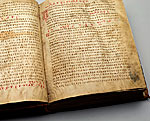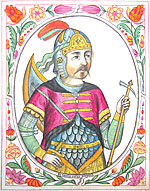Content
After describing the outward appearance of the manuscript, we will turn to its text.
The Laurentian Codex, like any other Russian chronicle, is a compilation of a wide variety of works that belong to separate genres and were created at different times by different authors, mostly unknown. Chronicles is based not only on the written sources, but also on the oral, on the rich folk tradition. The story relating to events from the distant past in the pre-Christian "preliterate" Russia was written with use of historical legends and tales. People's memory has preserved the tales about the deeds of both warrior princes and unnamed common people, the recollections of the terrible invasions of the nomads, the tragic civil wars, the great victories and bitter defeats. All this makes the Laurentian Codex a precious testimony on the historical consciousness of the nation, which provides invaluable material for understanding the world view of Russian people.
The account of the Laurentian Codex traditionally begins with the biblical times, from the division of the earth among the sons of Noah, and continues untile 1305. The manuscript opens with Primary Chronicle or "Tale of Bygone Years", 'This is the tale of bygone years: from whence came the Russian land, who first ruled in Kiev, and from which source the Russian land had its beginning' (Selections from the Primary Chronicle were translated by Samuel H. Cross and were published in Harvard Studies and Notes in Philology and Literature, Volume 12, 1930). This title refers to the most ancient extant chronicle composed at the beginning of the 12th century. The original compilation, which is by tradition attributed to the monk of the Kiev-Pechersk Monastery Nestor, has not survived. The Laurentian Codex has preserved the second, and the oldest surviving edition of the Nestor's Chronicle, revised in 1116 under the Kiev Prince Vladimir Monomakh by Hegumen Sylvester, the head of the St. Michael Monastery in the village of Vydubychi near Kiev.
Placed at the beginning of the Laurentian Codex, the extensive historical and geographical introduction provides a historiographic framework for all Russian chronicles. The origins and ancient history of the Slavic tribes are shown here in a vast background of world history. The book depictes the boundaries of native Slavic lands and the territories they developed, ranks the Slavs among other nations tracing their ancestors back to the descendants of the legendary Noah.Going on to the account about the history of Russia is marked by the division of the text in the weather records. The building up a chronology on the base of weather records is a major feature of Russian chronicles, in contrast to Western European tradition of recording events using the periods of the regnal years of the rulers. The first date given in the Laurentian Codex is 852. Starting that year, according to the chronicler, the name "Russian land" came into the world. And the record for 862 contains the legend of the Varangians' invitation that was developed into the historiographic concept of the origin of the Great Princes of Kiev, the ruling Russian princely dynasty, from the Varangian Prince Rurik.
Then it narrates about the capture of Kiev by Oleg, the origin of the Slavic alphabet, the Kievan Princes Igor, Olga, Sviatoslav, the internecine strife among Svyatoslav's sons, about the Prince Vladimir the Great and the Christianization of Kievan Rus', fighting between princes after the death of Vladimir the Great and the murder of Princes Boris and Gleb, about Yaroslav the Wise, his educational activities and testament to his sons (it defined the primary role of the Kiev prince whom the other princes must obey), Yaroslav's successors on the Kievan throne - Princes Izyaslav, Svyatoslav, Vsevolod and Svyatopolk. The narrative covers many events stamped in people's memory, but the main topics are the struggle against raids of the Cumans, and the internecine warfare of princes (especially notable is a tragic story of the blinding of the Prince of Tver Vasilek).The "Tale of Bygone Years" in the Laurentian Codex finishes with an appendix by the hegumen Sylvester, the head of the St. Michael's Monastery in the village of Vydubychi near Kiev, the Bishop of Pereyaslavl Yuzhniy from 1118. This mainly describes the reigns of Vladimir Monomakh, who was crawned in Kiev in 1113 after the death of Sviatopolk and transfered the chronicle from the Kiev-Pechersk Monastery to the monastery of St. Michael in his village of Vydubychi. Sylvester's revision affected chiefly the times of Sviatopolk and Vladimir Monomakh. He emphesized the important role of Monomakh in conducting the Congress of the Russian Princes in 1097 in Lyubech as well as his efforts to maintain peace between the princes. The "Tale of Bygone Years" was the last all-Russian chronicle before the dissolution of Kievan Rus'.
Later narrative of the Laurentian Codex, in M.D. Priselkov's opinion, combines the local chronicles of Vladimir, Rostov, and Tver Principalities which were the most important political centers of the Period of Feudal Partition.
The Laurentian Codex contains several codices of the Vladimir Chronicles. The first of these was initiated by Andrew Bogolyubsky and completed in 1177 after the assassination of the prince. The account of second chronicle of Vsevolod the Big Nest continued up to 1193, and, finally, the third, glorifying that prince, was composes in 1212 by his son Yuri Vsevolodovich. In preparation of the Vladimir Chronicles, South Russian sources were drawing up, namely, the chronicles of Pereyaslavl Yuzhniy, because Vladimir princes believed the city to be their patrimony (now in its place is modern Pereyaslav-Khmelnitsky).
Recounting events after 1212 until the 80s of the 13th century, the Laurentian Codex closely followed the chronicles, which were kept in Rostov (the city of Vladimir by that time had been destroyed by the hordes of Batu). These are the 1239 codex of Yaroslav Vsevolodovich (based on the chronicles of the Rostov Prince Constantine and his sons), the codex of 1263 and the chronicle of 1281.
The narration of the Laurentian Codex on events from 1284 to 1305 are based on the Tver chronicle. This was a codex of Vladimir Yaroslavovich of Tver, reigned as Grand Prince of Vladimir from 1305. It included not only records by the chronicler of the Prince of Tver, but also by the family chronicler of the Smolensk and Yaroslavl Prince Theodore Rostislavich the Black as well as the chronicles of Novgorod and Ryazan. The account of the Tver codex, continued up to 1305, was united with the preceding annals of Vladimir and Rostov. This compilation formed the old chronicle which served as source for Monk Laurentius in 1377.
But Laurentius did not just transcribe the text. The researcher V.L. Komarovich proved that, in the Laurentian Codex, the description of the Prince of Vladimir Yuri Vsevolodovich was radically changed to positive from negative, compared to the Tver Codex of 1305, (this Yuri Vsevolodovich was the founder of Nizhny Novgorod where Laurentius very likely worked). Hence, the text was critically rethought when copying, and inserted sheets at the end of the chronicle suggest that the already-written manuscript was re-edited. The scholar G.M. Prokhorov has convincingly shown that the editing involved the portion of the text which tells about the Tatars, the invasion of Batu into Russia and the subsequent history of relations between Russia and the Tatars. Changes affected the interpretation of the Tatar theme, and the editing tended toward the historic rehabilitation of those Russian princes, whom other documents accused of playing an ignoble role.
And here we must recall Dionysius of Suzdal who initiated the creation of the Laurentian Codex. There is no doubt that it was he who controlled the ideological editing of the text, or even he personally edited it. The Laurentian Codex was destined to give the reader examples of the courage of princes, their religious intolerance to the Tatars. The revision of the text was done hastily, so that Laurentius was assisted with the editing of a manuscript by another scribe, in whose hand the text was written on the insered sheets 157 and 167, as well as the end of the text on the back of the inserted sheet 161. This scribe joined Laurentius when work entered final stage. He used the uncial style of writing, but by no means had the professional skills. G. Prokhorov who was the first to draw attention to the person of Dionysius of Suzdal in connection with codicological features of the Laurentian Codex, is inclined to believe that Dionysius resolutely carryed out the editorial changes in his own hand.Evidently, we should be grateful to Dionysius of Suzdal also for the interpolations in different parts of the text, which are found only in the Laurentian Codex and turn it into a landmark, invaluable for its uniqueness. For instance, as part of the Laurentian Codex, the famous autobiographical Instruction of Vladimir Monomakh - a masterpiece of Old Russian literature, proclaiming the high principle of morality in politics with candor surprising for Middle Ages, has come down to us in a single copy.




